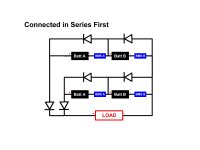llile
1 kW
- Joined
- Dec 18, 2010
- Messages
- 457
Re: Diodes and charging question…
Postby dnmun » Thu Jan 12, 2012 5:13 pm
you do not need diodes to connect them in parallel. period. just be certain they are charged to the same voltage before connecting them in parallel. i think i already covered it, not sure why it is so hard to understand.
you do not need diodes
you do not need diodes
you do not need diodes
diodes make heat and rob power, they will catch your pack on fire if they are in the bag with the pack.
you do not need diodes.
Well, I respectfully disagree. Li Ping recommends the attached circuits for series and parallel batteries. Let's pick them apart and try to understand them, shall we?
What does that diode in parallel with the battery do? Apparently it is always reverse biased, and no current would flow, right? Nope, it does have a function.
Take a look at this Wikipedia article http://en.wikipedia.org/wiki/Flyback_diode for a little background on flyback diodes, then think through the following:
Your motor is a large inductor. Inductors will resist changes in current flow. If you suddenly cut off voltage to an inductor, current will continue to flow in the same direction, generating a large negative voltage spike, in the opposite polarity to the original voltage. Suddenly, there is a big negative voltage across your battery, and the sensitive electronics of your BMS. Kapow! But the reverse biased diode in parallel with your battery suddenly becomes forward biased, and returns this current safely to the inductor. This protects the BMS. I don't know it the battery itself would be damaged by the spike, but electronics certainly would.
These spikes can be extremely high voltages. In electronics class, we used to zap unsuspecting N00bs by having them measure the resistance of a large inductor, while holding the bare leads with their fingers. The 1.5 volt battery in the ohmmeter (this was in the old school when ohmmeters had DIALS as God intended) would charge the inductor, and inevitably the current would eventually be broken, generating a large flyback voltage, which then zapped the unsuspecting greenhorn holding the leads, generating mirth all around, except for him.
It is common to see flyback diodes on motors, relays, and coils. I've seen microcontrollers fried because a relay in the same circuit had no flyback diode. The flyback diode is a great idea to protect the BMS.
How about the series diode? Well, you can argue that it does waste some power, and I'd agree. A diode that carries current normally does generate heat, and you have to account for that if you use it. If you put it inside a bag, and haven't accounted for the heat, you may cause some trouble. Properly heat sinked it should be OK.
The series diode is protecting one battery from discharging into the other, and ensuring that, if one battery is stronger than the other for any reason, current goes into the motor rather than the other battery. I don't know if a LIFEPO will be damaged by reverse current flow, or just charged. I also don't know what this does to the sensitive BMS.
If these two battery packs are perfectly balanced, and charged to exactly the same voltage, then the diodes would not accomplish much. But what if they are not? One weak cell, variations in cell voltage? If one pack is weaker than the other, esp as they age, then the stronger pack will likely take most of the current. Will your battery packs really deliver the rated energy, if one pack is taking all the load? The diodes in this case help balance the two packs. This is also a commonly used circuit in various contexts from RV batteries to electronics.
How will one know if the batteries have been charged to the same voltage? I suppose one could add voltmeters, but most people just plug in the battery chargers at the end of a ride and leave it. What if the BMS are not balanced? What if one forgets to plug in one of the batteries? There are enough variables that I'd argue the series diodes add a level of safety, of course with some attendant complications.
How much heat? How much power? Let's say you are using a 72 volt battery pack and a nominal 1000 watt motor. That could be a pretty fast ride. You'll be pulling on the order of 14, lets say 15 amps to make the math easy. Each diode handles half this current. The datasheet for a Vishay 100BGQ100 Schottky diode says it would be dropping about 0.6 volts at that current. 0.6*7.5 = 4.5 watts for each diode or 9 watts for the pair. That's certainly going to need to be clamped onto a piece of metal. Isolated inside a bag that diode is certainly going to get too hot. But how much is 9 watts? It drops the efficiency of your 1000 watt motor by a little less than 1%. Maybe your flash flag uses up a similar amount of power. Lose the knobby tires, and you've probably made up for it.
If Li Ping recopmmends the series diode, I am liable to believe him. I'd like to hear From people who have run without the series diodes, how did things fare as the battery packs age? Has anyone done any measurements on battery capacity? I know there are strong advocates of not using series diodes in a parallel battery, however I believe that, properly designed, they probably do add some value.



